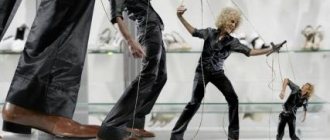Probably everyone has heard such a concept as a “cult of personality”. What first comes to mind when you mention it? Most often, attempts to explain its meaning are based on general information about the most famous dictators, known from history textbooks, and come down to listing some of their features. So what is it really?
When talking about this concept, we are talking about the exaltation or even deification of a person who is at the head of a country or any religious organization (for example, a church). His role in the life of the country and the functions he performs are exaggerated to incredible proportions, and power is considered undeniable or even sacred (depending on ideology and attitude towards religion). The power of the leader is revered as given from above, and in the minds of his people he himself is endowed with certain superhuman abilities, for example, to change the course of history at his own discretion or to directly control the fate of every citizen of the country. Most often, this phenomenon occurs in countries with totalitarian and authoritarian government systems.
Turkmenistan – Saparmurat Niyazov
Turkmenistan gained independence after the collapse of the USSR in 1991. 8 years later, in 1999, Saparmurat Niyazov became the lifelong president of Turkmenistan. Attempts by political opponents to remove Saparmurat Niyazov from the presidency were unsuccessful. All opponents were sent to prisons or psychiatric hospitals, and the media glorified the current ruler. Niyazov is also famous for his rather strange prohibitions. For example, he prohibited the showing of ballet and opera on television, and the wearing of long hair and beards by young men. Saparmurat Niyazov also changed the names of months in honor of his family members.
What is a full-fledged personality of a citizen?
Speaking about a fully and comprehensively developed person and citizen, we are talking about such a concept as “personal culture”.
Personal culture is, in the first case, the level of human development, his potential, abilities and talents, and in the second, a set of social and political competencies, that is, the ability to:
- to take responsibility;
- participate in the discussion of joint decisions;
- resolve conflict situations without the use of violence;
- participate in making joint decisions regarding the activities of certain social institutions;
- understand cultural and linguistic differences and treat representatives of other nations and cultures with respect.
The formation of a person’s culture occurs in the process of training and education under the influence of his social environment and depends on his individual need for development and improvement.
Equatorial Guinea - Francisco Macias Nguema
Francisco Macias Nguema's reign began in 1968 and lasted until 1979. Immediately after receiving the post of leader of the country, Ngema gave himself full power over all branches of government. In 1972, Nguema united all the country's political parties into the United National Party, after which a referendum was initiated. Through a referendum, Nguema appointed himself president for life of the country. Any attempts to resist the ruler were suppressed, and the most objectionable ones were simply killed. As a result, in 1979 a coup d'etat took place in Equatorial Guinea and the rule of Francisco Macias Nguema ended.
Cult in ancient times
It is safe to say that a religious cult in any form is already proof of the existence of intelligence in a living being.
After all, to create it you need to have imagination and logic (albeit primitive). Subsequently, man found more and more phenomena that seemed to him stronger than a simple living creature. There was a worship of almost all elements of nature that could be both useful and harmful to humans - rivers, forests, animals and plants. Therefore, as soon as people ceased to be animals and acquired certain mental skills, the cult was not slow to appear.
Apparently, man paid his first veneration to nature’s most precious gift – fire. After all, keeping the hearth, making fire, even the simple lighting of a “torch” from a common fire - all this had the appearance of a ritual. Fire was the first companion of a person, which helped him, made his life easier, or destroyed everything in its path if he was “angry”. Traces of the cult of fire remain in every mythology of the world - just remember the legend of Prometheus.
Iraq - Saddam Hussein
Saddam Hussein became the fifth president of Iraq. This happened in 1979. Hussein's rule lasted until 2003. Hussein's main achievement was the close interaction of the military with the work of the government. As a result of Hussein's rule, the country managed to nationalize oil production and gain control over most banks. All these achievements were accompanied by the elimination of opponents and other repressions. According to one version, at least 250,000 people were killed during the entire existence of Saddam Hussein's regime. Hussein's cult of personality ended in 2003 when the US army invaded the state and captured the country's leader.
Causes
Social psychologists are convinced that the emergence of such phenomena as the cult of personality or idol worship is determined by a certain social environment. It is society that creates the following prerequisites for the emergence of such a cult of personality:
- Political and legal immaturity of people, lack of cohesion and civil society.
- A large number of individuals, the main characteristic of which is socio-psychological infantilism, that is, the inability to predict the consequences of their own actions and bear any responsibility for what they did.
- Low level of culture and education in society (among most of its representatives). Culture and personality give way to the consciousness of the individual.
- Intolerance of dissent in society up to its complete eradication.
- The reasons for the emergence of the cult of personality also include the need for ideological reinforcement of the functioning of the regime.
- The influence of the leader's personal qualities (for example, oratory, charisma and exceptional qualities of intelligence and thinking).
- Manipulation of the consciousness of the masses and its mythologization, that is, the formation of an (artistic) image based on events that actually took place.
All these factors create ideal conditions for the establishment of a totalitarian and authoritarian state system with an exalted leader at its head.
North Korea - Kim Il Sung and Kim Jong Il
The most popular cult of personality today is the situation in North Korea. At one time, Kim Il Sung initiated this cult of personality by establishing strict rules for separating people (sonbun) in the country and introducing an ideological system. In 1994, after the death of Kim Il Sung, his son, Kim Jong Il, continued to rule the country. Then the cult of personality of Kim Il Sung was added to the cult of personality of Kim Jong Il. Today, this cult of personality has been supplemented by the cult of personality of the current ruler of the country, Kim Jong-un.
Purposes of creation
In addition to achieving universal admiration, the creation of such a phenomenon as a cult of personality pursues clear practical goals:
- Instill fear in your enemies
The feeling of the presence of the leader's personality everywhere inspires serious fears in everyone who dares to think about a coup.
- Appearance of invincibility
There are hardly anyone who would want to compete for power with an infallible god-like being. The main thing is that people perceive the leader as the guarantor of the existence of the state and their own well-being, as an equal to God or his earthly incarnation.
- Unlimited power
Only a few of those who believed in the personality of the dictator dare to challenge his decisions or at least somehow express protest.
- Creation methods
The path to creating each individual regime certainly has its own characteristics, however, there are a number of general methods that leaders successfully use:
- Creating Leader Images
Placing portraits, statues or other images of the dictator in crowded places. The people should see their leader every day, and the more often the better. Everyone should know who exactly is at the helm.
- Assigning titles to a political leader
In addition to the title denoting the position held in the state, dictators often assign to themselves other sonorous epithets that speak of courage, strength, love and their paternal love for their people.
- Creation of a state ideology with a sonorous name
Ideology is created in the image and likeness of religion, and the main role in it is, of course, given to the political leader.
- Publishing your own books
The population of the country should know what political views its leader has, what ideas come into his head. These works should contain not only political reflections, but also moral and ethical instructions. The publication of fiction books or books with one’s own sayings in a small, convenient format is very popular.
- Presence in all news
The media should closely monitor the life of the leader and immediately report to the country any news, even insignificant, with the exception of those carrying negative information. The culture and personality of the leader must be united: artists must be encouraged to create works about the head of state.
- Naming objects after a leader
Streets, schools, businesses, squares, cities, airports, awards and even mountain peaks can bear the name of a dictator. It all depends on the imagination of the one who is creating the ideology.
- Publishing unusual laws
The purpose of such actions is to show the people who exactly makes decisions in the state. Laws may seem stupid and meaningless, but they achieve their purpose.
What if we move away from the sacred?
However, a religious cult is just an item (albeit a huge one) on the list of a person’s worship. A cult does not always carry within itself a higher and divine charge, a desire to explain the world. Our world and history are essentially filled with different varieties of worship.
One of the most important cults in the history of mankind can be called the cult of power. He came to us from the cruel animal world, where the presence of strength is a must for survival.
The strongest (alpha) instantly becomes the main one. Without his permission or knowledge, weaker beings cannot do anything. However, these same betas and gammas follow each other in the same way, creating a simple hierarchical ladder, where the weakest (omega) is obliged to worship the strongest.
A similar animal structure can be clearly seen in schools, where children have not yet learned to control themselves and splash out all the bestiality that is left to us from our ancestors.
Religion
No matter how important the awareness of the existence of God is for most of the inhabitants of the Earth, in its pure form, religion is the cult of the Supreme Being, and nothing more. It is the worship of a certain single, independent and omnipotent being that is central to monotheistic religions.
A religious cult is, in addition to worshiping God directly, also endowing a huge number of artifacts and rituals with a certain sacred, higher meaning. Following these very rituals (repentance, communion in Christianity, for example) is one of the main pillars of religion. With their help, you can satisfy the Supreme Being, and for non-compliance, you can anger him.
Religion plays a huge role in human history - so big that it is difficult to overestimate. The world's faiths (Buddhism, Christianity, Islam), in fact, contain all the moral standards of behavior for modern man. Religion thus became higher than a simple cult, that it turned from frightened admiration into a teaching, an attempt to bring human life into a grace-filled order. It is the presence of philosophical impulses that puts religion at a level higher than cult.
Afterword
In my opinion, most cults are negative in nature, the rest are neutral. I practically don’t see any positive cults. Each of them deprives a person of independence and hinders development.
Useful worships include, for example, the cult of a healthy lifestyle or the cult of education. But everything is good in moderation, and excessive enthusiasm turns into obsession. A person becomes a hostage to an idea; it becomes a goal, not a means. Because of cults, wars, contradictions, personal anxiety, and complexes arise.
A cult is the ignoring and suppression of individuality, the abilities and characteristics inherent in a person. This is the desire to equalize all people, moreover, to make them similar to a certain ideal. At the same time, the emphasis is placed on a negative attitude towards oneself, failure, and not on love and acceptance, and the disclosure of personal potential.
When and how Khrushchev read the report on the cult of personality
On February 25, 1956, at a closed meeting of the 20th Congress of the CPSU, Nikita Khrushchev made accusations against Stalin. His report shocked the delegates present. According to eyewitnesses, during the first secretary’s speech, there was dead silence in the hall.
“We went down from the balcony and didn’t look at each other’s faces. Either from a feeling of surprise, or from shame or shock,” this is how Alexander Yakovlev, who at that time worked in the schools department of the CPSU Central Committee, described the atmosphere, writes TASS.
After this, the “secret report” was distributed to all party organizations. He attracted attention not only in the Soviet Union, but throughout the world.
Rational cult
Two most important eras in human history brought another cult. It can be called purely human, devoid of an ancestor from the world of cruel nature.
This is the cult of reason. The presence of rational, logical thinking, thanks to ancient philosophers, is considered the main asset of a person. The ability for his own thought is placed much higher in him than the worship of Supreme Beings.
A rational being must set itself the goal of understanding the world through science, as well as maximum objectivity in its knowledge. The cult of reason often excludes the very idea of Deity - simply because we see no evidence of the intervention of a Supreme Being in human affairs.
In France during the Revolution, this phrase carried the antithesis of mainstream Catholicism. At that time, the cult of Reason became a whole Parisian movement aimed at establishing the dictates of science. Its participants disrupted masses and services, destroyed altars, while trying to enlighten the people through reading books.
At some point, the movement got lost in the abyss of revolutionary actions. However, the denial of the divine and the placing of the human mind on the highest pedestal, and the presentation of objectivism as the main good, was greatly reflected in the events under the slogan “Freedom! Equality! Brotherhood!"
Mass repression
The punitive-repressive apparatus and the security forces are being strengthened:
— 1924 — The Central Executive Committee of the USSR approved the “Regulations on the rights of the OGPU regarding administrative expulsions and imprisonment in a concentration camp.”
- 1930 - the Directorate of OGPU Camps was formed under the Council of People's Commissars of the USSR, renamed in 1931 the Main Directorate of OGPU Camps (GULAG).
- 1934 - The People's Commissariat of Internal Affairs (NKVD) of the USSR was formed. It included the OGPU in its entirety, transformed into the Main Directorate of State Security.
— Since November 1934, a Special Conference (“Big Three”) was formed under the People’s Commissar of Internal Affairs, which was given the right to administratively send “enemies of the people” into exile or into forced labor camps for up to five years.
— The Secret Department of the NKVD was created, which was engaged in the destruction of political opponents of the authorities who found themselves abroad (in August 1940, Leonid Trotsky was killed in Mexico, many figures of the Comintern and the white movement became victims of the Stalinist regime).
Changes in the system of government institutions in the 1930s. testified to the formation of the foundations of a totalitarian regime with a powerful repressive apparatus.
1928 - “The Shakhty case” served as an impetus for the launch of the fight against “pests” from among the scientific and technical intelligentsia in all sectors of the national economy.
1930 - trial of the Industrial Party; "The Case of Academicians".
Early 1930s - mass repressions against kulaks and “sub-kulak members”. On August 7, 1932, the Central Executive Committee and the Council of People's Commissars of the USSR adopted the law “On the protection of the property of state enterprises, collective farms and cooperation and the strengthening of public (socialist) property” (the “five ears of corn” law), according to which even minor thefts were subject to a long term of imprisonment or execution .
The reason for the deployment of mass repressions in the country was the murder on December 1, 1934 in Leningrad of S. M. Kirov, a member of the Politburo of the Central Committee of the All-Union Communist Party of Bolsheviks, the first secretary of the Leningrad Provincial Committee of the All-Union Communist Party of Bolsheviks. A few hours after this murder, a law was passed introducing a “simplified procedure” for the consideration of cases of terrorist acts and organizations. The strengthening of Stalin's regime of personal power was facilitated by the wave of the “Great Terror”.
The end of December 1934 - a closed trial of members of the so-called Leningrad center.
April 7, 1935 - The resolution of the Central Executive Committee and the Council of People's Commissars ordered that “minors, starting from the age of 12, convicted of committing thefts, causing violence, bodily harm, murder or attempts to murder, should be brought to criminal court with the application of all criminal penalties” , including the death penalty.
1936 - the first of the major trials of the leaders of the intra-party opposition (G. Zinoviev, L. Kamenev, etc.). Prosecutor A. Vyshinsky accused them of the murder of Kirov, of attempts to kill Stalin and overthrow the Soviet regime.
1937 - the second trial, during which another group of leaders of the “Leninist Guard” was convicted. Most of the accused were sentenced to death (G. E. Zinoviev, L. B. Kamenev, G. L. Pyatakov, N. I. Bukharin, A. I. Rykov, etc.). It is significant that the victim of the third Moscow trial was G. G. Yagoda, who headed the NKVD until September 1937, when he was replaced in this post by N. I. Yezhov.
June 1937 - after a one-day trial in a military tribunal, Deputy People's Commissar of Defense M. N. Tukhachevsky and 7 prominent military leaders - heroes of the civil war - were shot. This was only the beginning of large-scale terror, which affected not only the senior, but also the middle and junior command staff of the Red Army. In fact, in 1937-1938. the army and navy were beheaded. Thus, of the five people who were the first to receive the rank of Marshal of the Soviet Union, established in 1935, three were shot (M. N. Tukhachevsky, V. K. Blyukher, A. I. Egorov).
March 1938 - the third trial took place. The former head of government A. Rykov and the “favorite of the party” N. Bukharin were shot.
A wide network of concentration camps is being formed. Mass repressions of the second half of the 1930s. played an important role in strengthening the totalitarian regime and Stalin’s personal power. The terror also had an economic significance: millions of prisoners worked on the construction sites of the first five-year plans, contributing to the economic power of the country.









